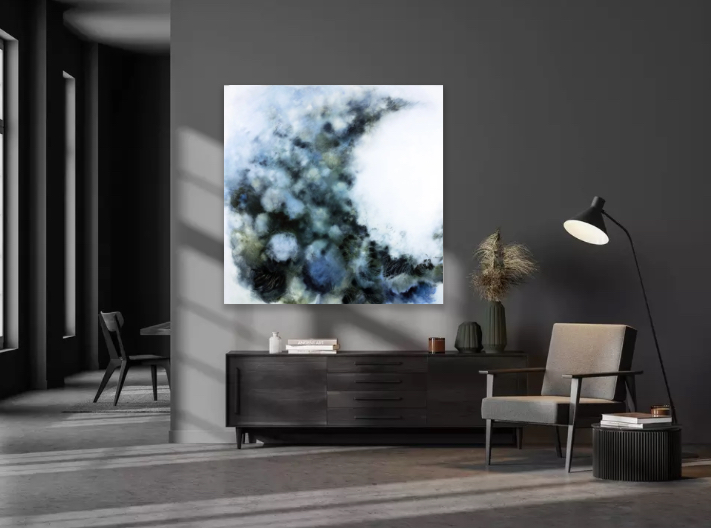“You never arrive, but you keep going in the hope that you will.”

With this sentiment, Gina Parr introduces us to a painting that is less an object and more an open field—of memory, of emotion, of elemental truth. High as Hope (2024), Parr’s oil-on-canvas composition, stands not merely as a work of art, but as a beacon of psychological excavation—an abstract, multi-layered journey through hope, heritage, and hard-won resilience.
Constructed with oil, charcoal, soft pastel, and acrylic, the work resists easy classification. And that is precisely its power. It is abstraction not as aesthetic indulgence, but as memoir. A visual diary where figuration flirts with erosion, and where the boundaries of landscape dissolve into the fluid topography of personal history.
The Canvas as a Conscious Terrain
At the heart of High as Hope is tension—the kind that emerges between freedom and containment, motion and stillness, recollection and distortion. This duality is rooted in Parr’s childhood: days spent with her fisherman father in the open coastal landscapes of Devon, versus the oppressive, cluttered atmosphere of her mother’s compulsive hoarding.
This contradiction is etched into every inch of the canvas. The work’s title alone—High as Hope—is aspirational but tinged with melancholy. “Hope,” here, is not a destination but a vertical reach, a longing suspended mid-air, just as the brushstrokes themselves seem to hover, drift, or resist full resolution.
Look closely, and the piece becomes a psychological map. The cerulean blues evoke ocean expanses and emotional depths. The ochres and rusts suggest sediment, decay, sedimented time. And the smeared charcoal and pastel interruptions? They are memory’s shadows—shorthand for wounds, repairs, refusals, releases.
Materiality as Emotional Code
Parr’s materials do not sit quietly. Oil paint mingles with watery acrylic washes, while coarse pastel lines scratch against glazed surfaces. She pushes the surface of the canvas toward its edge, working with her hands, sponges, palette knives, and brushes in almost ritualistic repetition.
This is not painting for the sake of form. It is painting as performance. She often begins by pouring water across pigment, watching as colors resist and absorb, spread and retract. There is surrender in her process, but never passivity. The pigment reacts, Parr responds—a dynamic that mirrors the push-pull of memory itself.
Charcoal introduces the element of fracture. It is dry, ephemeral, easily disrupted. Yet it is used with confidence, often cutting across the softness of oils like geological strata. Soft pastel, meanwhile, disrupts the solidity of the scene with gestural smears, intimate marks that feel like whispers against an otherwise roaring backdrop.
Each medium in High as Hope performs a psychological role: oil for presence, pastel for yearning, charcoal for rupture, and acrylic for atmospheric diffusion. The composition becomes less an image than an ecosystem of sensory cues.
Abstraction as Biography
Though abstract, Parr’s works are profoundly narrative. They do not depict stories, but they contain them. In High as Hope, the abstraction is not a denial of form—it’s a disguise for memory. There are echoes of cliffs and moors, of salt winds and distant waves. But no single contour stays fixed. The viewer is never given the security of a horizon line. Instead, we drift.
This drifting is intentional. Parr describes her artistic space as “chimerical”—a blending of real and imagined geographies. Her landscapes are both inner and outer, fictional yet deeply personal. And her method allows for these spatial contradictions to coexist.
The absence of defined figures or architectural structures grants the viewer agency. We are not told where to look or how to feel. Rather, we are invited to bring our own memory to the surface—to project, to wander, to question.
Technical Vocabulary: Spatial Alchemy
Parr’s training as a production designer is evident in her acute spatial intelligence. Having spent 25 years at the BBC shaping visual narratives—working on EastEnders and collaborating with cultural figures like David Bowie—she understands how visual form constructs emotion.
In High as Hope, this training manifests not through illustrative clarity, but through compositional control. The balance of mass and void, of color and grayscale, of surface texture and translucency, is choreographed with theatrical precision.
Unlike some abstract painters who work within the same gestural register across a canvas, Parr engineers dynamic zones. One quadrant may be awash in delicate blue haze, suggesting ephemerality, while another anchors the composition in heavy pigment—a sedimentary gesture recalling both geological history and emotional depth.
This spatial thinking recalls the stage: you can almost imagine the canvas as a set, each region holding a distinct emotional tone or thematic weight, all coalescing in a single act of visual revelation.
Critical Reception and Curatorial Context
Critics have lauded Parr’s work as “emotionally charged, technically assured, and strikingly original.” Her hybrid vocabulary—drawing as much from color-field abstraction as from confessional art—resonates within both contemporary and institutional circles.
High as Hope was prominently exhibited in the 2024 group show Immersed and Imbued at One Paved Court Gallery in Richmond, where it was heralded as a show-defining piece. Its inclusion in the 2025 Cornucopia exhibition in Bath further confirms its curatorial relevance, situating Parr within the lineage of contemporary British abstraction that is deeply personal yet culturally reflective.
The painting’s availability through Rise Art—with international shipping and a collector-focused acquisition policy—also signals a growing institutional appetite for Parr’s layered language.
Interdisciplinary Synergy: Photography as Painterly DNA
While Parr is primarily known as a painter, her photographic practice bears significant influence on her painted compositions. She refers to photography as “painting with a camera,” and often captures blurred, liminal seascapes that serve as emotional cues for her studio work.
This influence is visible in High as Hope through its sense of motion-stilled, like a long exposure. The canvas seems to breathe. Soft edges blend into distant atmospheres. Hard lines appear only to dissolve. It mimics the uncertain contours of a half-remembered dream.
In this way, her photography and painting become dialectical. One medium proposes, the other answers. In High as Hope, that answer is full of longing.
Gendered Space and the Female Interior
There is something unapologetically interior about Parr’s abstraction—an honesty in its tactile layering, its somatic movement, and its refusal to sanitize the emotional terrain. This vulnerability situates her within a lineage of female abstractionists for whom the canvas becomes a site of catharsis and confrontation: Tracey Emin, Joan Mitchell, and contemporary figures like Cecily Brown.
Yet Parr carves a path that is distinctly her own. Her language is not purely gestural nor strictly conceptual. It resides in the liminal—in-between. In this sense, High as Hope can be read as an embodiment of feminist space: emotional, autobiographical, and radically unconstrained by male-centric formalism.
Her use of color, meanwhile, resists codification. Blues are not “cool.” Ochres are not “earth.” Instead, they are emotive states. Her chromatic decisions operate beyond theory—they are instinctual, corporeal. They come from the gut, not the grid.
Legacy in the Making
Parr’s inclusion in prestigious collections—such as Keble College, Oxford, and private commissions including a bespoke canvas for Glen Scotia’s 2025 release—signals a trajectory beyond the gallery wall. Her work is collected not only for its aesthetic merit, but for its emotional intelligence.
As of 2025, High as Hope remains one of her most critically resonant pieces, encapsulating the emotional thesis of her recent work: that abstraction, when grounded in truth, can surpass figuration in clarity.
The painting stands as a testament to the power of personal narrative elevated through universal form. It belongs not just in collections, but in conversations—about the role of memory in art, the elasticity of landscape, and the ongoing redefinition of what it means to hope.
Impression: An Infinite Vertical of Hope
High as Hope is not about finality. It’s about continuance. In this single work, Gina Parr achieves what few painters dare: she holds us in a space where longing is both the subject and the medium. The painting does not impose its story; it makes space for ours.
In a cultural moment obsessed with speed, with surface, with virality, High as Hope asks us to linger. To stand still. To breathe.
And perhaps that is what makes it full.
No comments yet.









